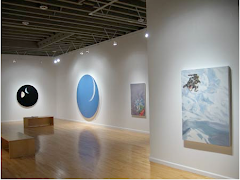On Kawara: Sunday Painter
At The Power Plant Contemporary Art Centre
Toronto
November 12, 1967
Marilyn Clink and Laurie Smith are first year undergraduates at Waterloo Lutheran University. Marilyn is from Toronto and majors in mathematics while Laurie, from Newmarket, studies geography. They met at a school social the month previous and are fast becoming good friends. On this day, Laurie and Marilyn are both attending chapel. Laurie is a trained singer. He is somewhat religious, but mostly attends chapel religiously so that he can sing in the choir. He loves to sing. Marilyn is also somewhat religious or at least her father, Allan, says grace before every meal. Marilyn mostly attends chapel on Sundays to hear Laurie sing, or rather, to watch him sing. Today he is performing the Lord’s Prayer as a solo. He has a beautiful voice. It fills the room. His chin strains and his neck trembles as he resonates in perfect pitch. His body is taught as he reaches the hymns grand crescendo. Then there is silence. The congregation does not applaud a church performance. God however, is supposedly clapping. Laurie sits back down amongst the choir. Marilyn is smiling in her pew. On this day, eight years later, John Laurie Smith and Marilyn Elizabeth (Clink) Smith will have their first child. He is seven pounds and eight ounces. They name him Peter.
December 24, 1978
I am three years old and I’ve finally got this whole Christmas thing figured out. There’s this really nice big fat old guy who wears pretty much exclusively red, has a long white biker style beard and brings presents to all of the kids around the world. He works the rest of the year, along with his team of highly trained and efficient magical elves, making all of this stuff whilst recording and tracking the naughty/nice behavior patterns of the world’s youth. I am convinced that Clint Bolger, my best friend, has absolutely no hope of receiving anything at all this year. I am hoping however that Santa, in his infinite wisdom and benevolence, can overlook my reluctant participation in the infamous throwing of crab apples into Bobby Best’s swimming pool incident. (It made great splashing sounds!) At least when I talked to Santa at the mall, he seemed relatively willing to listen. This year I am hoping for as much Star Wars paraphernalia as elf-inly possible. Luke Skywalker is the only action figure that I would articulate as truly “necessary”, yet Han Solo and Darth Vader are pretty important components to any real Star Wars adventure. They also, of course, need some kind of vehicle (or two) to get around the galaxy/sand box.
February 16, 2005
I am given a ride home by one of my professor’s along with a visiting artist who is giving a talk tonight at the Power Plant. I’d been meaning to check out the show for awhile, mostly because some friends have stuff upstairs in the Cold City show. I was decidedly less intrigued by the prospect of seeing the works by On Kawara. I felt that his famous “date paintings” were one-trick-ponies that offered little benefit to actually seeing them first hand. Conceptual one-liners are like magic tricks, once you know how they work there seems little point in witnessing their actual incantation. Because of this preconception, I was completely unprepared for the melancholic weight that Kawara’s work powerfully resonates. Firstly, these paintings aren’t all the same. They are in different scales and fonts. There are minute variations in tone and hue. Each painting seems to have subtle imperfections, tiny moments where the artists hand is clearly visible. These calculated indiscretions provide the work with a touch of humanity, transforming the cold transference of fact and information into something personal and introspective. For there is something deeper that lurks behind these characters. Walking though this collection of On Kawara’s date paintings is like walking through a grave yard. These paintings seem haunted. If a photograph is, as Barthes famously stated, “a death mask of a moment”, then Kawara’s paintings are tombstones of a day, with the date alone standing as epitaph. Like most good work, these paintings understand that meaning is created less by the artist than by the viewers, who bring with them the various dramas of their own memory and experience. Where was I on July 6th, 1980? What happened on that day? Was it the same as any other day? The paintings in this exhibition are heavily loaded with these sorts of resonances because On Kawara’s palette is not the mid-value grey of these monochromes but is rather the expansive palette of our memory.

video footage from Sudden Frost at Elissa Cristall, Vancouver
Will Gorlitz at Michael Gibson Gallery

John Eisler at Diaz Contemporary

Michel Daigneault at AKAU

No comments:
Post a Comment